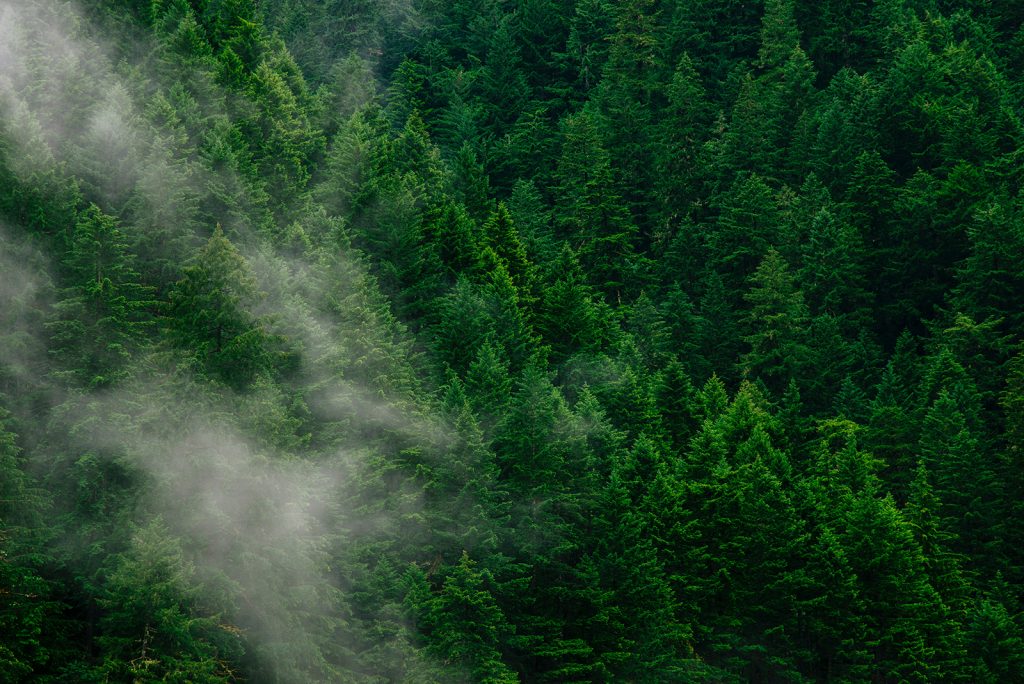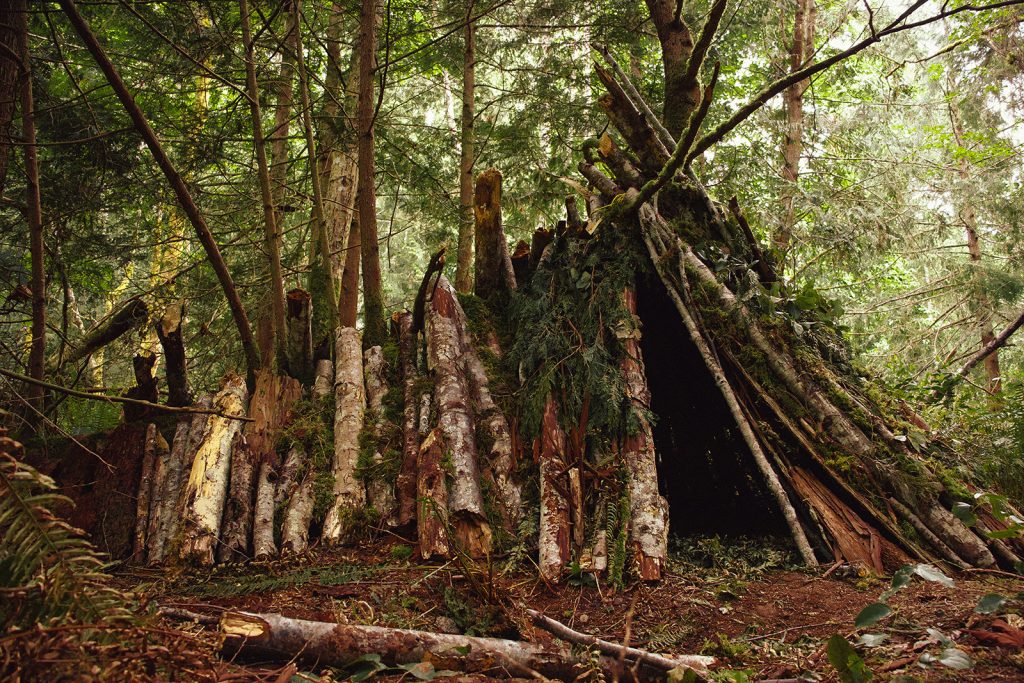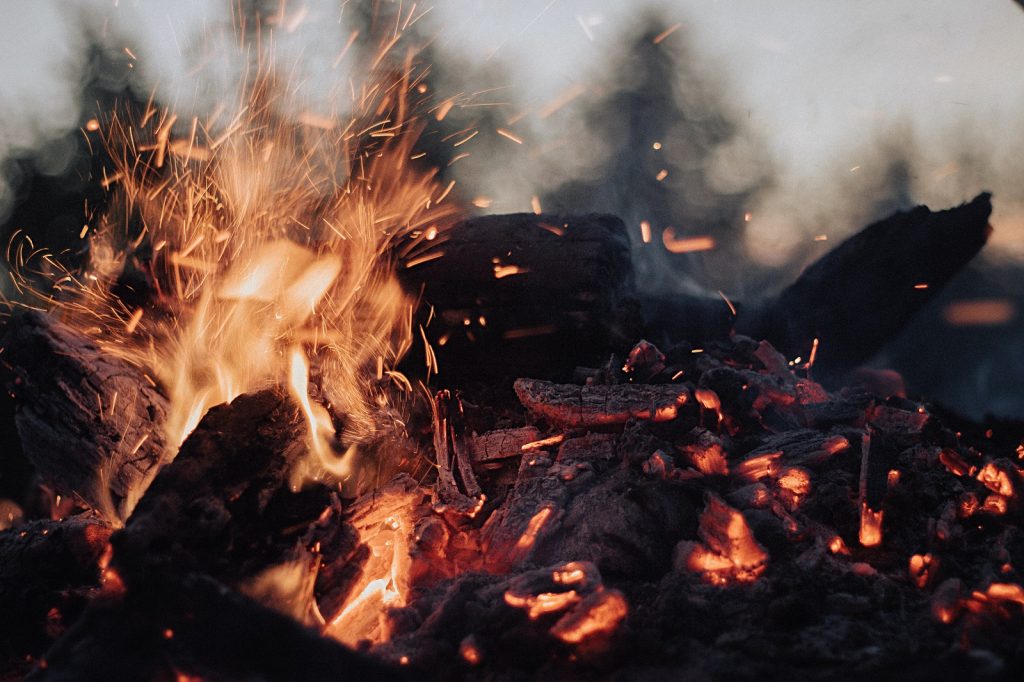Outdoor survival is incredibly testing and pushes humans to the limit. Whether you are lost during a hike, evacuating from a disaster, or are simply trying a survival challenge. You will be tested in many ways, forced to use your brainpower and skills, and pushed into difficult and potentially life-threatening situations. As a result, you must be prepared and have an idea of what it takes to survive. In this particular guide, we look at how to survive in the woods for one week.
Forests and woodlands can be difficult places to survive in. Navigation is often difficult due to the lack of light, and the lack of landmarks. You may also come across obstacles like wild animals, falling branches, and a lack of water. However, woodlands also have some advantages. For example, you can find ample material for firewood, and it is much easier to build a shelter here. In this guide, we explore woodland survival, the challenges you may face, and the tasks you will need to complete to remain safe and alive!

Survival Circumstances
Before we jump into the guide, let’s take a look at the different circumstances you may find yourself in where survival is needed. This is important because it can affect your level of planning, and the ease with which you can survive in the woods.
A survival challenge
Firstly, there is voluntary survival! Yes, people are actually crazy enough to place themselves in survival situations with no food, shelter, or equipment! If you love the outdoors and want to test your skills, you may opt for a survival challenge. This is essentially a pre-planned excursion where you intend to survive in the woods for as long as possible.
The benefit of this type of woodland survival is that you have more time to plan. You can scout the location beforehand and get an idea of the conditions you are facing. Also, you have more opportunities to prepare a survival kit. You may not be parachuting from a helicopter like Bear Grylls, but a survival challenge can be a life-changing experience.
Getting lost during an outdoor trip
Next, we move onto the first type of involuntary survival. Simply put – getting lost. For example, you have embarked on a long hike into unknown territories, and you unwittingly get lost and cannot find your way back to your starting point.
It is surprising how often this happens, particularly in forests. When hiking in vast woodlands, it can be far more difficult to keep your bearings if you are not following a man-made path. This is because the scenery can look incredibly similar, and it can be difficult to pick out landmarks.
Survival when getting lost offers a little more safety. This is because you most likely have a small supply of food and water that you planned to use during your hike. This initial supply can at least help you until you can find water and food sources in the woods.
Evacuating from an external threat
Lastly, you may need to survive because you have been forced from your home. For example, there could be an immediate natural disaster in your area like a hurricane, tsunami, or earthquake. Alternatively, you may live in a conflict zone.
These situations present some of the toughest survival conditions. This is mainly due to the lack of preparation, but also the increased mental strain.
Understanding the Potential Dangers of Woodland Survival
Knowledge is incredibly important to survival. The more you know and understand, the better prepared you will be for different survival situations. When looking at how to survive in the woods for one week, you must understand the potential dangers. If you do not understand the dangers, how can you hope to prepare for them or prevent them? For woodlands, the main dangers are cold temperatures, dehydration, starvation, and wildlife threats.
Extreme Cold
Firstly, during any outdoor survival experience, the cold can be your worst nightmare. Keeping warm is an essential part of survival as you will see below. In forests and woodland, you have the benefit of shelter from the wind. This can make temperatures a little warmer.
However, during the night, or during wet weather, the woods can be incredibly cold. This can affect your health in a number of ways. However, the two most common ailments are hypothermia and frostbite. Hypothermia occurs when your body temp drops below 35 degrees Celsius. If not prevented, this can ultimately cause death.
Frostbite results from the cold damaging your body parts. The most commonly affected areas are your exposed extremities such as your feet, hands, ears, and nose. In mild cases, your skin will blister and cause pain. In extreme cases, your skin will blacken, and you may lose limbs or appendages completely.
Dehydration
It is a fact that humans cannot survive without water for more than 3 days. Dehydration can easily occur in a forest if you are not near any natural water source. Eventually, your body will simply shut down and you will die. However, other complications from dehydration include seizures, hypovolemic shock, and kidney failure.
Starvation
We can survive longer without food – up to 7 days. However, it is not advised to do so. Having a lack of food can cause many problems, especially when you are out in the wild and trying to survive. Without sufficient food, you will lack energy. You will start to feel constantly tired and weak, and basic tasks will become incredibly difficult.
Malnutrition can also affect your eyesight and cause long-lasting damage to your organs. Luckily, in forests, there is often a variety of food sources you can find.
Wildlife threats
Lastly, forests can often have dangerous wildlife that could attack you. You may find larger and more dangerous animals like bears and wolves in forests. Aside from these obvious threats, there is also potential danger from smaller animals, insects, and bugs. For example, you could get bitten by an animal that is carrying an infectious disease or bitten by a poisonous insect.
How to Survive in the Woods for One Week – The Key Tasks
With a keen understanding of the potential dangers, you can turn your attention to the tasks you will have to complete during your week of survival. The difficulty of these tasks will vary depending on the terrain, weather, and conditions that you encounter. However, these four tasks will form the cornerstone of your survival attempt.
Finding or Building Shelter
Even in warm weather conditions, it is not advisable to try and sleep on the forest floor. The floor may be damp, and it may not provide for a comfortable experience. Also, without some type of shelter, you will become cold quickly which can lead to other complications.
As a result, you must find, or build a shelter. Firstly, you can try to find shelter. In woods, you may find caves, or there may be large, exposed tree roots and hollows that you could sleep under. When using natural shelters like these, make sure you have explored them thoroughly and cleared any debris and mess. Also, you may want to insulate them using moss and dry leaves.
Secondly, you may have to build a makeshift shelter. A shelter can be built using logs and branches you find on the forest floor. Alternatively, you may have to cut some larger branches. If possible, try to create a shelter off of the ground. This will help keep you dry, but also provide some protection from wild animals at night.

Staying Warm
Staying warm is important. In forests, you can easily get cold and this could eventually lead to hypothermia. One of the best ways to keep warm is to create a shelter which we have detailed above. Having an enclosed area that shelters you from the weather will help keep your body temperatures up.
A campfire is also useful for keeping warm, and for cooking food. This is one skill we advise practicing before any survival adventure. In a forest, you should easily be able to find kindling and wood to start a fire. However, you must take extreme care when building a campfire in the woods. You are surrounded by potentially flammable materials – the last thing you want to do is start a forest fire.
Finally, if you are traveling with a friend or even a dog, you can share your body warmth to keep your temperatures up. It is a well-known fact that combing body heat is a great way to keep warm.

Finding water
Shelter and warmth will help keep the cold at bay, however, without water, your efforts will be in vain. Part of how to survive in the woods for one week is having access to clean drinking water. We cannot survive without water – this is a biological fact!
This is therefore one of the first things you should do. It is important to look for water before making shelter. In a worse-case scenario, you can sleep on the ground at least (although this is not advised), you cannot hope to survive without water.
There are two main sources of water when surviving in the woods – rainwater, and natural water sources. Finding a natural water source such as a stream, spring, or waterfall is the best solution. This will provide a constant supply of water and give you an area at which you can base your survival camp. Even if the water looks clear, however, it is still ideal to boil it if possible. Even clean running streams can contain harmful bacteria and microorganisms.
Rainwater is the next best water solution. You can comfortably drink rainwater without the need for boiling providing that it has not landed on any plants or trees with poisonous properties. You can easily use an item of clothing like a waterproof jacket to collect rainwater. Simply hang it between some tree branches and create a bowl shape so the water can build up – this is known as a water trap.

Finding food
With your shelter and water source found, you can turn your attention to food. We can last for up to 7 days without food, so the need for this is not as urgent as water. However, a lack of food can still cause you to feel drained and tired – this will not help when you are trying to survive.
When in a forest, you generally have two options – catching wild animals, or foraging. Catching and killing wild animals requires far greater skill, effort, and time. However, the rewards are far greater as the cooked meat will provide far more energy and nutrients. In contrast, foraging requires less effort, but the bounty may not be as fulfilling or nutritious.
In forests, you may be able to catch and kill small animals like squirrels. Squirrels are generally safe to eat when cooked properly. To do this, however, you must be able to either create a trap or create some type of throwing stick to impale the animal. You must also be able to create a campfire and have the means to cook the meat.
Foraging also has its pros and cons. The downsides are that you may have to expend a lot of energy to find only a few small natural items and that you may accidentally eat poisonous or unhealthy items. The upsides are that forests often have an abundance of foraging foods, and you don’t have to expend energy catching and killing animals. Typical items you may find include berries, nuts, tree bark, flowers, and plants.
Getting back to civilization
Regardless of if you are trying a survival challenge, or are lost, you should have the end goal of reaching civilization and finding safety.
If you are lost during a hike, hopefully, you at least have your smartphone or a map. Using a smartphone and a GPS signal, you can easily find where you are, and look for the best route to safety. It may also be beneficial to download an offline map of the area you are hiking in beforehand. If you lose signal, you can at least use the map for navigation.
If you do not have a smartphone, or it is unavailable, a map and a compass are incredibly handy. Ideally, you should have an idea of the area and landmarks before setting out. You can then use compass points to head towards landmarks and work your way back to safety.
Another simple trick often used is to follow water. If you can locate a river or a stream in the woods, following it could lead you back to civilization.

Preparation for Surviving in the Woods
It is possible to prepare for surviving in the woods – even if you simply get lost during a hike, for example. There are many things you can do and practice beforehand to improve your chances of survival. Also, there are things you can do to prevent the possibility of getting lost and needing to survive.
Create a basic survival kit
Depending on the type of survival situation, you can create a survival kit. For example, if you are evacuating your home, you can have a bug out bag ready. You can read our bug out bag checklist to see what type of items this should contain. However, the basic premise if that this kit will contain equipment and rations to last for at least three days. If you live in an area where natural disasters are often, a bug out bag is a great thing to have prepared to help survive in the woods.
Alternatively, for your survival challenge, you could create a basic survival kit. Exactly what you pack in this kit depends on how difficult and realistic you want to make your survival challenge. Most survival experts will only carry minimal items such as a water bottle, a whistle, a camping knife, a fishing line, and a lighter. This gives them some basic tools, but still keeps the experience realistic, and means that they still have to do most of the work themselves.
For survival challenges, you may want to start with a larger survival kit and reduce the items in it each time as your confidence and skills grow. For example, the first time, you may include some basic food rations and water.
Research the surrounding area
We appreciate that it is not always possible to research your surrounding area. For example, if you have to evacuate your home during a natural disaster. However, if you are undertaking a survival challenge, or even if you get lost during a hike, you can prepare.
When undertaking a survival challenge, you should research the area fully. Firstly, you must check if you can legally attempt your challenge in the area, and if there is any private land. The worst thing you want to happen is to enrage a farmer or local landowner! Secondly, we advise checking on the availability of water. Knowing that there is something like a stream somewhere in the area offers some comfort. Thirdly, have an idea of the nearest populated area, or the nearest roads and public byways.
If you are undertaking an outdoor adventure to somewhere new, research can help reduce your chances of getting lost and needing to survive! Ideally, you should try and have either a digital or printed map of the region. Also, you should again look at the closest settlements, roads, and potentially plan some escape routes to safety.
Improve your knowledge of edible food sources in the wild
When surviving outdoors, you will have a limited food supply. As a result, you have to understand what you can eat in the wild. There are many different plants, flowers, and fungi that you can eat. You can of course catch, kill, and cook wild animals and game too.
If you want to be an expert survivor, we, therefore, advise improving your knowledge of edible foods in the wild. Ideally, you should be able to identify different types of plant and flower, and know which ones are edible. You should also have an idea of the different nutrients they provide, and what basic foods will give you the good stuff you need to survive.
You may be surprised at the wide variety of edible foods available in the wild and woods. Some examples include sorrel, dandelions, clovers, burdock, and amaranth. The more knowledge you have, the less likely you are to eat some poisonous or dangerous food by accident. The following are some useful guides on edible plants and food in the wild:
https://www.artofmanliness.com/articles/surviving-in-the-wild-19-common-edible-plants/
https://www.fieldandstream.com/eat-woods-20-wild-foods-to-help-you-stock-pantry/

Practice making a campfire
As mentioned above, staying warm is one of the most important things when surviving outdoors. One of the best ways to do this is to make a campfire. However, this is not usually something you can easily do without practice or training.
There are many ways to build a campfire and how effective it is will depend on the surroundings, the weather, and the items you use. Luckily, in a forest or wooded area, there should at least be plenty of twigs, logs, and kindling.
Regardless, you may still find it tricky to start a fire, especially if you have no prior experience. Therefore, we strongly advise improving your campfire-making skills by practicing. You could practice building and lighting a campfire in your garden, in a local forest, or even at a local park. If you do this somewhere else except your home, always be careful not to damage the surroundings, or leave a noticeable spot on the ground.
You should practice the different stages of making a campfire and try to recreate conditions you may experience in a forest. For example, you should practice gathering timber and kindling, building the campfire structure, and keeping it hot. We have a brilliant guide you can use on how to build a campfire which stays hot.

Consider a dry run first
Aside from practicing making a campfire, it could also be beneficial to practice a woodland survival experience. You could try a dry run. This would help you improve your skills, get used to the conditions, and see how to survive in the woods for one week.
For the dry run, you don’t have to go full survival mode. Instead, you could take some equipment and supplies, so that you are in no real danger. For example, you could take a tent, a camping stove, and have plenty of food and water supplies.
Whilst this would not test your survival skills fully, it would still allow you to experience the outdoor conditions, and what it’s like to sleep in a forest. Also, you could utilize this dry run to practice scavenging for water and food and making shelter. Think of a dry run as a training exercise where you can develop your survival skills in preparation for a real challenge or unexpected event.
For any outdoor expedition, check-in with others
Regardless of the situation, it is always advisable to check-in with at least one other person. This holds true for an evacuation event, when getting lost, or when attempting a survival challenge. If at least one other person knows where you are, and what you are doing, the chance of rescue is far greater if something goes wrong.
The information you should provide must be as detailed as possible. This should include the general area you are traveling to, a planned hiking route, your starting time and date, and when you intend to return. This information will allow others to help you in the event of danger or call rescue services if you have not returned by your scheduled date.
You could also consider using the What 3 Words App to give someone your precise expected camping area before a survival trip. This is a useful location app that identifies the world in a series of tiles that each have three associated words.
Test Yourself and Your Survival Skills With a Week in the Woods
We hope you have found this guide on how to survive in the woods for one week useful. This information should improve your chances of survival if you get lost, or if you have to evacuate due to an emergency. In these instances, the immediate goal is to survive. However, you should also keep the end goal of reaching safety.
Alternatively, this information should also help if you are planning a solo or group survival challenge. A survival challenge can be an incredible event. It will test your knowledge, push your limits, and let you see nature in a different light. Completing a survival challenge in the woods will also boost your confidence, and show hidden skills and depths you didn’t know you had!

